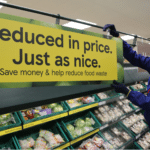
Confused by the date labels on your groceries, and how to determine when good food goes bad? One grocery chain has a novel idea – get rid of date labels altogether and let you figure it out for yourself.
How’s that for eliminating confusion? Now your food never actually expires! Technically, at least.
The change is taking place in Britain’s Tesco grocery chain. It’s a limited move, for now, affecting dozens of prepackaged produce products. So you’ll still be able to check the date on your cheese, or Cheetos, but when it comes to determining when your bag of potatoes or shrink-wrapped package of peppers expires – you’re on your own.
Tesco points out that loose, individual produce items don’t have expiration dates, so why should packaged produce? Besides, it says, too many people have been relying on date labels, rather than their own judgment, and throwing out perfectly good food before it goes bad.
“We have made this change to fruit and vegetable packaging as they are among the most wasted foods,” said Mark Little, Tesco’s head of food waste. “We know some customers may be confused by the difference between ‘best before’ and ‘use by’ dates on food, and this can lead to perfectly edible items being thrown away before they need to be discarded.”
If the concept works for packaged produce, could it work for other grocery products throughout the store? And could it work in the U.S.?
Few in the U.S. have gone so far as to advocate eliminating date labels altogether. But there have been several proposals to streamline the unwieldy array of terms used on expiration date labels. “More than 10 different date labels on packages – such as Sell By, Use By, Expires On, Best Before, Better if Used By or Best By – can result in confused consumers discarding a safe or usable product after the date on the package,” the Food Marketing Institute and Grocery Manufacturers Association said in a joint statement early last year.
So the two grocery industry groups proposed just two standard date labels – “Best if used by”, which indicates when a product is past its peak quality but still safe to eat, and “Use by”, which indicates when certain perishable products should no longer be consumed.
Tesco’s idea is not just aimed at eliminating confusion, but at helping to eliminate the growing problem of food waste. Other recent proposed solutions to the problem have come in the form of a report that suggested eliminating buy-one-get-one-free deals, for fear that they encourage “over-purchasing and spoilage”, and another British grocery chain that actually sells expired packaged products for pennies on the dollar so they don’t end up in the trash.
The thing about expiration date labels, however, is that they’re designed as much for retailers as they are for consumers. The dates not only tell consumers when the product should be consumed, but they tell retailers when to pull them off the shelves. So if a store like Tesco eliminates dates on many of its products, how can shoppers be confident that store staffers aren’t slacking off on rotating out old stock, or knowingly trying to pass off old food as fresh?
Tesco says it has “rigorous stock rotation procedures in place” to ensure that truly expired food doesn’t remain on the shelves. So you’ll have to take their word for it – or pick up a product and squish it and smell it to test it yourself.
You know, just like you did before fresh produce even had expiration date labels.
In the meantime, the FMI and GMA’s joint proposal to overhaul date labels doesn’t appear to be gaining much traction. When they proposed it last year, they emphasized that “retailers and manufacturers are encouraged to immediately begin phasing in the common wording with widespread adoption urged by the summer of 2018.”
Well, we’re weeks away from the summer of 2018, and streamlined date labels are far from being fully in place. When it comes to date labels, then, it seems even the proposed solution is about to pass its “best by” date.
Image source: Tesco










